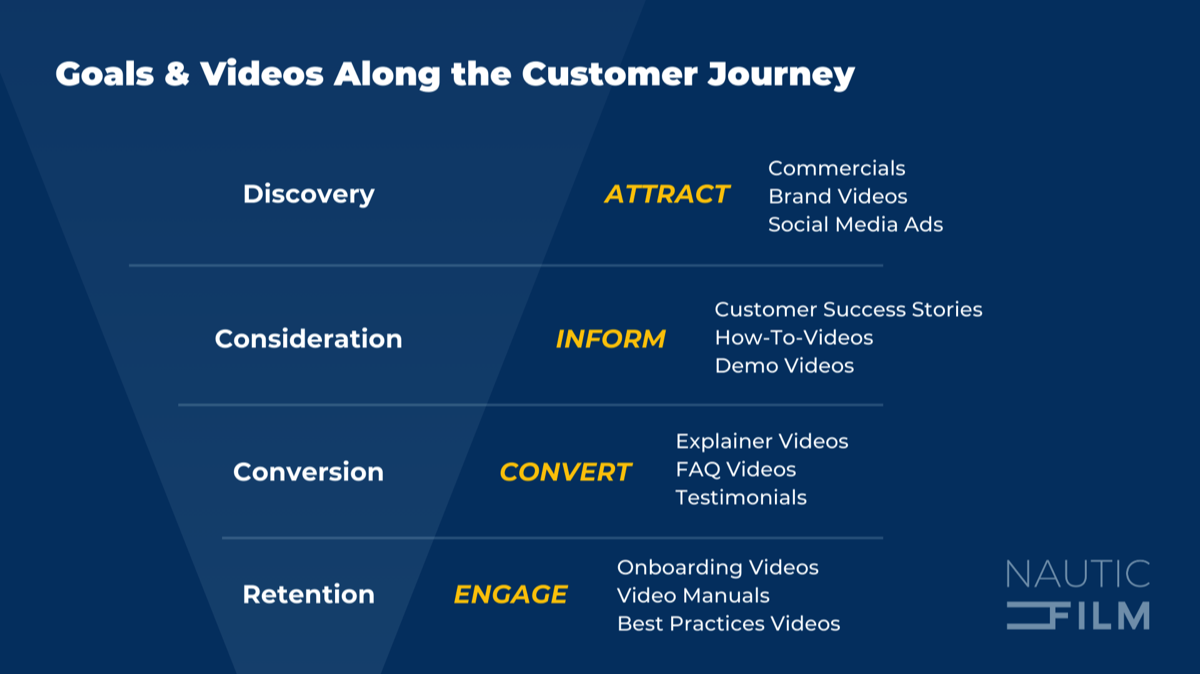Navigating the Customer Journey

Discovery Stage:
At this stage, it is important to introduce your product to potential clients and make them aware of your brand. Investing in ads is one way to be discovered by new buyers. Social media and YouTube advertising are effective and cost-efficient methods of reaching your target audience. To make the best impression, present your highest quality video content at this stage. Brand videos, commercial spots, and social media ads are common forms of video content here.
Consideration Stage:
Once potential buyers are aware of your product, they begin evaluating different solutions. Building rapport and familiarizing clients with your product and brand is crucial at this stage. Use how-to videos and product demos to showcase your product features. To keep costs low, these videos can often be produced in-house with your team members. However, it is still important to invest in professional production to ensure high-quality storytelling and production value.
At this point, one of the most effective tools is the customer success story, often referred to as a case study. These stories involve satisfied customers sharing their positive experiences with your product or service, providing social proof that can help build trust and credibility. It's important to ensure that these case studies are of a high quality standard to have the desired impact.
Decision Stage:
At this stage, potential buyers are almost ready to make a purchase decision. Providing detailed information about your product or service can help them make their decision. In-depth explainer videos and testimonials are effective forms of video content for this stage.
A secret weapon at this stage, particularly with complex products, is the FAQ-Video. Picture this: Before a sales meeting, the sales team sends a video addressing the common questions shared by 80% of potential buyers. Imagine how much more efficient and productive that meeting could be.
Retention Stage:
After making a sale, it is important to guide your clients toward becoming happy users of your product. Instructional videos can help onboard clients and replace written user manuals. Creating a video-centric online community around your product can also foster a sense of community and loyalty among users.
In conclusion, video is an essential component of B2B marketing in the marine industry. By using videos strategically throughout every stage of the customer journey, companies can increase engagement, build trust, and ultimately drive more sales.
At this stage, it is important to introduce your product to potential clients and make them aware of your brand. Investing in ads is one way to be discovered by new buyers. Social media and YouTube advertising are effective and cost-efficient methods of reaching your target audience. To make the best impression, present your highest quality video content at this stage. Brand videos, commercial spots, and social media ads are common forms of video content here.
Consideration Stage:
Once potential buyers are aware of your product, they begin evaluating different solutions. Building rapport and familiarizing clients with your product and brand is crucial at this stage. Use how-to videos and product demos to showcase your product features. To keep costs low, these videos can often be produced in-house with your team members. However, it is still important to invest in professional production to ensure high-quality storytelling and production value.
At this point, one of the most effective tools is the customer success story, often referred to as a case study. These stories involve satisfied customers sharing their positive experiences with your product or service, providing social proof that can help build trust and credibility. It's important to ensure that these case studies are of a high quality standard to have the desired impact.
Decision Stage:
At this stage, potential buyers are almost ready to make a purchase decision. Providing detailed information about your product or service can help them make their decision. In-depth explainer videos and testimonials are effective forms of video content for this stage.
A secret weapon at this stage, particularly with complex products, is the FAQ-Video. Picture this: Before a sales meeting, the sales team sends a video addressing the common questions shared by 80% of potential buyers. Imagine how much more efficient and productive that meeting could be.
Retention Stage:
After making a sale, it is important to guide your clients toward becoming happy users of your product. Instructional videos can help onboard clients and replace written user manuals. Creating a video-centric online community around your product can also foster a sense of community and loyalty among users.
In conclusion, video is an essential component of B2B marketing in the marine industry. By using videos strategically throughout every stage of the customer journey, companies can increase engagement, build trust, and ultimately drive more sales.
See the strategy in action on our showcase page
If you have any questions regarding your video strategy, please email us .
Best Regards
Gerrit Haaland
If you have any questions regarding your video strategy, please email us .
Best Regards
Gerrit Haaland

